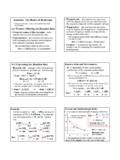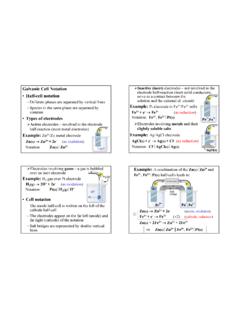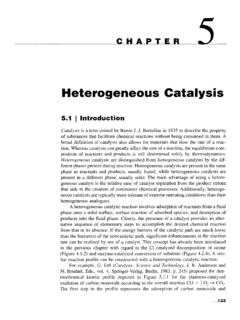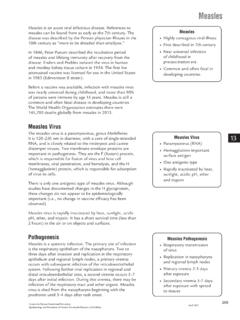Transcription of Kinetics: The Rates of Reactions – the reaction rate increases
1 kinetics : The Rates of Reactions Physical state the reaction rate increases with the degree of mixing (contact) between Chemical kinetics studies the reaction Rates and the reactants (depends on the reactant's phase). mechanisms Temperature the reaction rate increases Factors Affecting the reaction Rate with increasing the temperature ( increases the Chemical nature of the reactants each collision frequency and the average kinetic reaction has its own characteristic rate energy of the molecules). The reactants must collide with sufficient energy Concentration the reaction rate increases in order to react with increasing the reactant concentrations Rate Collision energy Temperature (the collision frequency increases ).
2 The reactants must collide in order to react Catalyst increases (or decreases) the reaction rate by changing the reaction path Rate Collision freq. Concentration (mechanism). Expressing the reaction Rate reaction Rate and Stoichiometry reaction rate change in the concentration C is dependent on the stoichiometric (C) of reactants or products per unit time (t) coefficients of the reactants and products Rate = C/ t For a reaction , A 2B. Units M/s or mol/L s The concentration of B changes twice faster than Reactant (A) Product (B) the concentration of A.
3 C < 0 C > 0 [B]/ t = 2(- [A]/ t). The rate is positive by convention, but C is (-) To make the rate independent of the choice of a for the reactants and (+) for the products reactant or product, we use the convention: For a reaction , aA + bB cC + dD. Rate = - [A]/ t or Rate = [B]/ t Square brackets represent the concentrations of 1 [A] 1 [B] 1 [C] 1 [D]. Rate = = = =. the reactant [A] and product [B] in mol/L a t b t c t d t Example: Average and Instantaneous Rates For the reaction N2 + 3H2 2NH3, the rate of The reaction rate typically changes with time formation of NH3 is M/min.
4 Calculate the C (C - C ). C Reactant concentration Rate = = 2 1. rate of disappearance of H2 and the reaction (C) versus time (t) t ( t 2 - t1 ). rate. = slope (a ). C1. [NH 3 ] M mol NH 3 Average rate in the = a interval of time (t1, t2). t min L min C b mol NH 3 3 mol H 2 mol H 2. = C2 Rate = slope (b ). L min 2 mol NH 3 L min Instantaneous t1 t t2 t rate at time t 1 [NH 3 ] 1 mol NH 3 mol NH 3. Rate = = = The instantaneous rate at time t is given by the 2 t 2 L min L min slope of the tangent (b) to the curve at this time As the interval of time (t1, t2)
5 Gets smaller, the slope Rate Laws of a approaches the slope of b and the average rate Rate law the dependence of the instantaneous approaches the instantaneous rate rate on the concentrations of the different species The instantaneous rate can be estimated by measuring the average rate in a narrow time interval in the reaction determined experimentally Normally the term reaction rate refers to the Example: 2N2O5(g) 4NO2(g) + O2(g). instantaneous rate Concentration versus Experimental rate law [N2O5]. Rate time from experiment Rate = k[N2O5].
6 Initial rate the instantaneous rate at time, t=0 Slope of d (the starting point of the reaction ). d Slope of c For most Reactions the rate decreases gradually after k is a the starting point so the slope of the tangents gets c Slope of b constant smaller with time (slope b Slope of a of line). Initial Rates are easier to measure and depend on the a initial concentrations which are normally known t a b c d [N2O5]. For most Reactions of the type Some Examples of Experimental Rate Laws aA + bB + Products General rate law expression: the rate law can be expressed in the form: Rate = k[A]m[B]n.
7 Rate = k[A]m[B]n Examples: 2N2O5(g) 4NO2(g) + O2(g). k rate constant (depends on the nature of A, B, Rate law Rate = k[N2O5]. and the temperature ). m = 1 first order in N2O5. m, n, reaction orders with respect to A, B, m + n + = 1 first order overall m + n + overall order of the rate law 2NO2(g) 2NO(g) + O2(g). Example: 2N2O5(g) 4NO2(g) + O2(g). Rate law Rate = k[NO2]2. Rate law Rate = k[N2O5]. m = 2 second order in NO2. m = 1 first order in N2O5. m + n + = 2 second order overall m + n + = 1 first order overall Examples: The Reactions orders are not related to the stoichiometric coefficients of the reactants CH3Br + OH- CH3OH + Br- The reaction orders can sometimes be fractional or Rate law Rate = k[CH3Br][OH-] negative numbers m = 1 first order in CH3Br The rate law can include concentrations of products n = 1 first order in OH- Examples: m + n + = 2 second order overall 2O3 3O2.
8 (CH3)3 CBr + H2O (CH3)3 COH + HBr Rate law Rate = k[O3]2[O2]-1. Rate law Rate = k[(CH3)3 CBr]. 2SO2 + O2 SO3. same as Rate = k[(CH3)3 CBr]1[H2O]0. Rate law Rate = k[SO2][SO3]-1/2. m = 1 first order in (CH3)3 CBr n = 0 zero order in H2O 2NH3 N2 + 3H2. m + n + = 1 first order overall Rate law Rate = k zero overall order The Reactions orders can be determined by Experimental Determination of Rate Laws measuring the changes in the reaction rate upon Determination of reaction orders and rate changing the reactant concentrations constants Example: The initial rate method the initial rate (Rateo).
9 For the reaction 2NO + 2H2 N2 + 2H2O, the of the reaction is measured at various initial rate increases by a factor of nine when the concentrations ([X]o) of the reactants concentration of NO is tripled while the aA + bB Products Rateo = k[A]om[B]on concentration of H2 is kept constant. What is the If [A]o is increased by a factor, f, while [B]o is order of the reaction with respect to NO? kept constant: Rate law Rate = k[NO]m[H2]n new Rateo = k(f [A]o)m[B]on = fm k[A]om[B]on 9 Rate = k(3 [NO])m[H2]n = 3m k[NO]m[H2]n 9 Rate = 3m Rate new Rateo = fm Rateo 9 = 3m m = 2 2nd order in NO The initial rate increases by a factor of fm Example: Determine the rate law for the Exp Relative Conc.
10 Relative Rate reaction O2(g) + 2NO(g) 2NO2(g) from the # O2 NO. following data: 1 Exp. Initial Conc. 10-2 (mol/L) Initial Rate 10-3 2 # O2 NO ( ). Exp Relative Conc. Relative Rate 1 # O2 NO. 2 1 3 3 Select experiments with the same concentrations of As [O2]o increases by a factor of , the initial rate one of the reactants (1, 2) and (1, 3) increases by a factor of 1st order in O2. Calculate the relative concentrations and Rates by As [NO]o increases by a factor of , the initial rate dividing with the smallest number in a column increases by a factor of 2nd order in NO.













